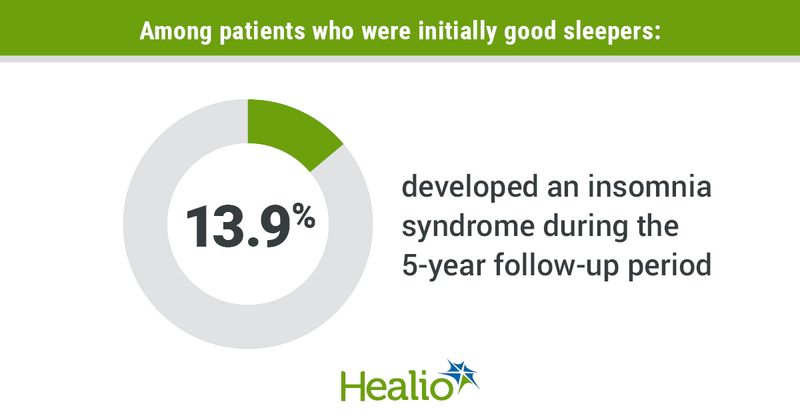Insomnia results in high health care burden, but often goes unrecognized, untreated
Insomnia represented a “persistent condition” in a study of a Canadian cohort that included more than 3,000 people, with more than 40% of individuals experiencing insomnia that continued for the entire 5-year follow-up period.
The findings may impact the prognosis associated with insomnia, as well as management of the condition, given long-term consequences seen with the disorder, according to the researchers, which can affect medical morbidity, psychological health and occupational outcomes.

“Although pathophysiologic features of insomnia remain largely unknown, there is increasing evidence showing that persistent insomnia is associated with long-term adverse outcomes, such as increased risk for psychological (eg, depression), occupational (absenteeism) and medical morbidity (eg, hypertension) and even reduced life expectancy,” the researchers wrote. “Despite its pervasiveness and adverse consequences, there is limited knowledge on the natural course of insomnia over long intervals, particularly related to incidence, persistence, remission and factors that moderate its trajectory over time. Longitudinal studies are critical to determining the course, risk and protective factors as well as long-term consequences.”
Charles M. Morin, PhD, full professor in the department of psychology at Laval University and Canada Research Chair in Sleeping Disorders, and colleagues aimed to review the prevalence, persistence and remission rates of insomnia and the most frequent courses of insomnia over a 5-year period. They included adult participants with and without sleep issues from August 2007 through June 2014 who filled out an annual survey about their sleep and health habits for 5 consecutive years. The researchers categorized participants at each assessment as being good sleepers, having an insomnia disorder or having subsyndromal insomnia. Participants also filled out a comprehensive survey about sleep and insomnia, lifestyles and work schedules, physical and mental health, and medication and substance abuse.
In total, 3,419 respondents completed the baseline evaluation. Of these participants, the researchers excluded 346 participants because they reported a sleep disorder other than insomnia (eg, sleep apnea; n = 327) or for other reasons (eg, missing data on sleep variables; n = 19), for a final study population of 3,073 participants. The mean age of participants was 48.1 years (range, 18-95 years) and more than half of participants were women (62.2%). Morin and colleagues classified participants at baseline as being good sleepers (n = 1717; 54.4%, weighted) or as having either subsyndromal insomnia (n = 818; 28.8%, weighted) or an insomnia syndrome (n = 538; 16.8%, weighted).
During the 5-year follow-up period, 13.9% of initial good sleepers developed an insomnia syndrome (95% CI, 11%-17.5%). The researchers found that women were more likely than men to develop an insomnia syndrome (17.6% vs. 10.1%; P = .03). Among participants with insomnia at baseline, 37.5% reported that insomnia persisted at each of the 5 annual follow-up visits.
Rates of subsyndromal insomnia were 62.5% at 1 year to 26.5% at 5 years. For syndromal insomnia, rates were 86% at 1 year to 59.1% at 5 years. However, remission rates among those with subsyndromal insomnia were almost double the rates among those with an insomnia syndrome at 1 year (37.5%; 95% CI, 31.7%-44% vs. 14%; 95% CI, 9.3%-20.8%), 3 years (62.7%; 95% CI, 56.7%-68.7% vs. 27.6%; 95% CI, 20.9%-35.9%) and 5 years (73.6%; 95% CI, 68%-78.9% vs. 40.9%; 95% CI, 32.7%-50.4%).
Yearly trajectories demonstrated that individuals who were good sleepers at baseline were 4.2 times more likely to remain good sleepers in the following year (95% CI, 3.51-4.89), but once they developed insomnia, they were equally likely to report symptoms (47% probability) than to return to being a good sleeper (53% probability) 1 year later. Likewise, participants who had an insomnia syndrome at any given assessment were more likely (adjusted OR [aOR], 1.6; 95% CI, 1.19-2.6) to remain in that status (persistence) than to improve (remittance) at the next assessment. Even among participants whose sleep improved, the odds of relapse were greater (aOR, 2.04; 95% CI, 1.23-3.37) than those to improve in the following year.
Morin and colleagues found that remission rates for all participants with symptoms and syndrome at baseline were 29.3% (95% CI, 25%-34.1%), 50.6% (95% CI, 45.7%-55.7%) and 62.5% (95% CI, 57.5%-67.4%) at 1, 3 and 5 year follow-up, respectively. This meant that 62.5% of participants who initially reported having insomnia symptoms or syndrome at baseline experienced at least one remission within the next 5 years. Remission rates for participants with subsyndromal insomnia nearly doubled the rates seen in individuals with insomnia syndrome at 1 year (37.5%; 95% CI, 31.7%-44% vs. 14%; 95% CI, 9.3%-20.8%), 3 years (62.7%; 95% CI, 56.7%-68.7% vs. 27.6%; 95% CI, 20.9%-35.9%) and 5 years (73.6%; 95% CI, 68%-78.9% vs. 40.9%; 95% CI, 32.7%-50.4%).
“Although insomnia is not always taken seriously in the medical community, there is increasing evidence that acute insomnia is a risk factor for future episodes of insomnia, that the presence of an insomnia disorder is associated with a greater risk for a persistent course and that persistent insomnia is associated with increased risks for medical (eg, hypertension), psychiatric (eg, depression) and occupational (eg, absenteeism) morbidity and mortality,” the researchers wrote. “Accordingly, the present findings may have important implications for the prognosis and management of insomnia.”
These implications include the role of insomnia severity as “a valuable prognostic indicator” for identifying patients with a greater risk for chronic insomnia disorder, according to Morin and colleagues. In addition, they suggested that “treatment should be initiated promptly” for patients who reported sleep disturbances, especially if their concerns are serious enough to meet criteria for an insomnia disorder.
“Despite its high prevalence and burden, insomnia often remains unrecognized and untreated,” the researchers wrote. “Health care practitioners are urged to intervene early with evidence-based interventions rather than assume that insomnia will remit spontaneously. Longitudinal studies are also warranted to evaluate whether early interventions could prevent the development of insomnia chronicity and reduce its associated morbidity.”
